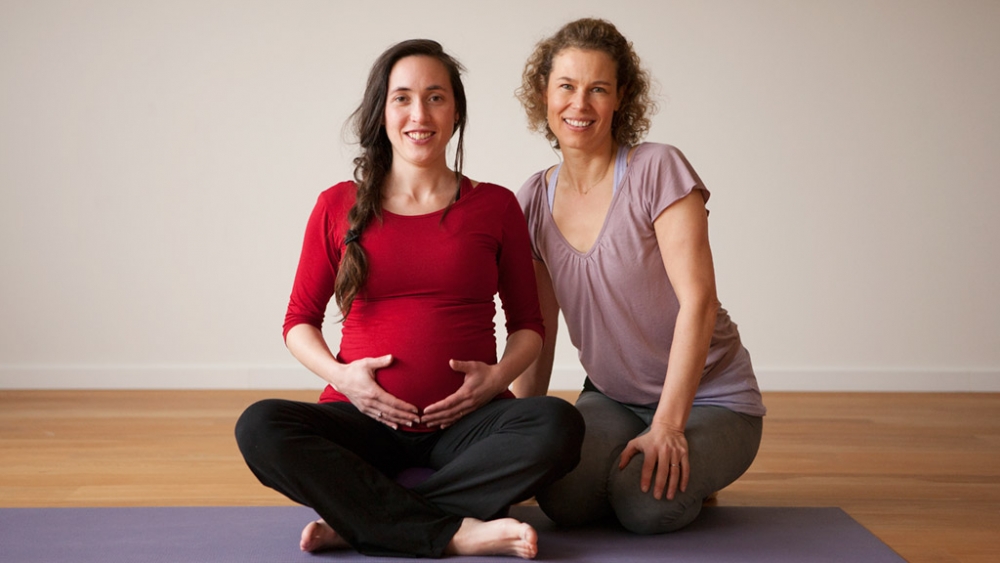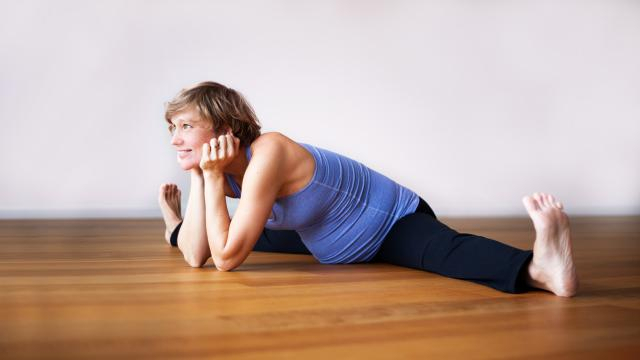Whether you start practising yoga after you get pregnant, or you have an established practice, yoga can help you to consciously connect to your baby and prepare you for your birth. Sandra shares her prenatal yoga tips to see you through your pregnancy.
Starting yoga during your pregnancy
Many new mothers-to-be who have no previous yoga experience benefit from a gentle and nurturing yoga practice. I was pregnant with my first daughter when I began practicing yoga. I had very little body awareness, a mediocre physical condition and no conscious breath experience. The yoga classes I attended were rich and educational. Movement, awareness and learning to breathe were some of the tools that were of tremendous help to me during pregnancy and birth. The classes offered me the opportunity to become more aware, to feel my body and to notice my body changing. Yoga invited me to connect with my baby in a different way than I was used to – connecting though my attention and intention, sending my love through my breath to my baby. It made me conscious of what else was out there, beyond the physical.
If you are new to yoga, use all the props you need and rest when needed. Generally the focus is on enjoying the movements, breath and the energetic connection to your body and baby. After your baby is born and you are fully recovered, you will have the opportunity to practice more strenuous yoga.
I’d recommend starting with prenatal yoga classes with a teacher who can guide you in person. You could complement these with pregnancy yoga online classes if you feel comfortable to, but this is a personal decision.
If you already do yoga and become pregnant
Many women who already have a yoga practice feel strong enough, after the first trimester, to continue their practice at roughly the same level as before. If the pregnancy progresses well, there is no reason why they shouldn’t. In my second and third pregnancies, I practised inversions and arm balances until the middle/end of my second trimester. Backbends felt fabulous as I was having back aches from the growing weight of my belly. Gentle twisting opened my lungs, so I had more space to breathe. I loved feeling and cultivating my own strength.
If you are an experienced yoga practitioner and your pregnancy is going well after your first trimester you may be able to follow many general yoga classes with some adaptations. Listen to your body and ease off when it tells you to.
- EkhartYoga members – see all our pregnancy yoga classes.
General tips for prenatal yoga
Here are a few tips I give all my pregnant yoga students:
1. Use props and give your baby space
Modify the poses, as needed, and use props to accommodate your changing shape. Place your hands on blocks and blankets under your knees in lunges. Use bolsters under your thighs for Cobra poses and be generous in giving yourself some more space and support.
2. Protect the Vena Cava
Try not to stay too long on your back during the second trimester as the baby’s weight might cut off circulation by pressing down on the Vena Cava. (This is the large vein that carries blood to the heart from other areas of the body.)
3. Adjust your balance
Keep in mind that your sense of balance can change significantly during pregnancy, making you less stable in balancing poses and inversions/arm balances.
4. Work on stability rather than flexibility
Levels of the hormone relaxin can increase very quickly in the body during the first few weeks of pregnancy. Relaxin is produced by your body to increase flexibility and soften the sacroiliac and hip joints to accommodate your baby passing through your birth canal. Be mindful not to stretch beyond your (pre-pregnancy) boundaries as this may cause issues later on – or even after your pregnancy. Focus instead on creating stable joints by keeping your muscles strong.
Prenatal yoga – tips for all trimesters
During your first trimester
You might feel tired, nauseous and lack energy to undertake any physical practice. Listen to your body, take all the rest you can. If you feel like this but want to do some yoga anyway, you could do restorative classes and gentle breathing exercises (pranayama). These are great to cultivate listening and connecting to this unique time in your body and life. Meditation may serve you well to help centre yourself in that part of you that remains unchanging, observing all that is growing and changing in your body and mind.
Take a look at our yoga classes for the first trimester.
During your second trimester
After the first 3 months, nausea usually subsides your energy will return. You may even feel more energetic than ever before! During these 3 months, you will start to notice the physical changes in your body in your practice. For example, lying on your belly will become more limited and eventually impossible. When doing standing forward bends, you will need to step your feet wider apart and when twisting you will be limited by your belly (so try to avoid deep twists and focus more on rotating the upper spine).
If you feel good and have no special precautions from your doctor or midwife, you can practise yoga almost to the extent you did before pregnancy. The hormone relaxin will start to kick in – meaning that suddenly you feel much more flexible than previously. Be mindful not to overstretch as to do so may cause issues in the later stages of pregnancy. In your practice, be observant and disciplined and don’t push yourself when stretching, twisting and back bending. Otherwise, you might enjoy a strong and active practice and that is fine.
Take a look at our yoga classes for the second trimester.
During your third trimester
Now you will start to feel your increased weight and the weight of your growing baby. Although a physical-focused practice is still fine to do (if you feel well and you’ve not been advised of any precautions) but be mindful of the increased relaxin in your body, as well as your body’s changes. These can include a different sense of centre, decreased sense of balance and more pressure on your joints and ligaments due to your increased weight. When you lie down, only do so on your sides and not on your back. Wide-legged standing poses can be done with your feet a little closer together (creating more stability) or with a chair.
Downward Facing Dog practising-moms-to-be have been known to “spin” their baby’s breech position even in the last trimester, so practice if it feels good! In either case, it might take the pressure off the pubic bone and babies often get excited when they get to be turned over.
Take time to rest, connect and nurture in your practice. Staying strong in pregnancy is great when it’s balanced with an equal amount of relaxation. Allowing your body to do what it needs to do, is best served when you can also have a sense of surrender. Being pregnant is wonderful and also taxing for your body, so take your well-deserved rest whenever you can!
Take a look at our yoga classes for the third trimester.
Practice our Pregnancy Yoga Program
Over the course of this program, José de Groot will guide you through yoga classes for different stages of your pregnancy including prenatal classes to enhance your fertility, pregnancy meditation, and Yin and Yang yoga for each trimester.


